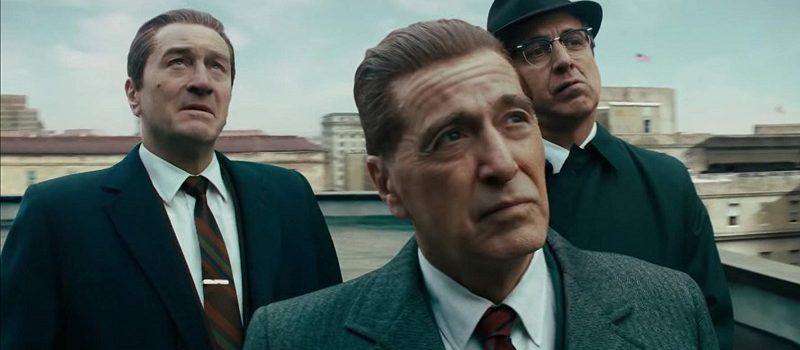The Irishman experience is serious business. Martin Scorsese has turned in his most reflective film of his career with his return to the mob movie genre that he has owned, along with a cavalcade of legendary actors who have done quite well in that milieu themselves.
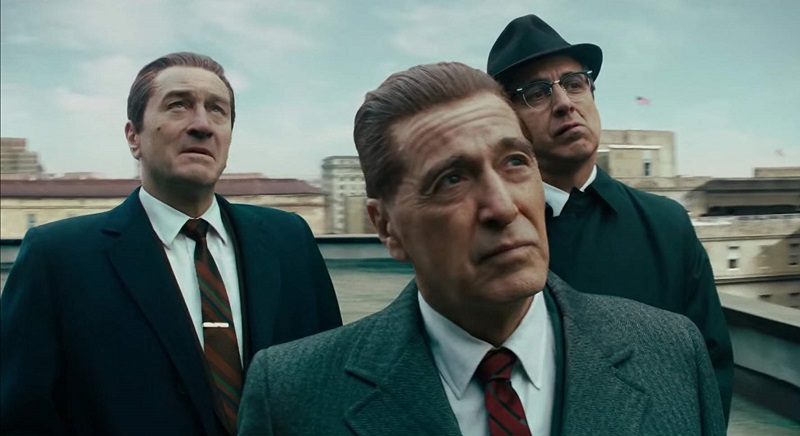
The cast list alone should get everyone to venture to their local theater (if you can find it, it should be seen on the big screen) or to hit click on Netflix. Robert De Niro, Al Pacino, Harvey Keitel and Joe Pesci (who won an Oscar the last time he was in a Scorsese mob movie) explore the true story of Frank Sheeran (De Niro)—a confidant in every sense of the word to Jimmy Hoffa (Pacino).
For those too young or simply unaware of the iconic historical figure that was Hoffa, the man served as the head of the Teamsters Union from 1957 to 1971. He was continually dodged by federal investigations and alleged ties to organized crime. Those rumors have only had their flames fanned by his 1975 disappearance and the mob’s penchant for making people vanish. On his deathbed, Hoffa’s confidant, Sheeran, admitted to killing his boss and dispensing of the body.
Scorsese makes masterful work of the script by Steven Zaillian (based on the book by Charles Brandt) and the timeline of Sheeran’s life by zig-zagging between a fateful road trip that the titular character and Pesci’s Russell Bufalino—a Philadelphia based crime boss—undertook with their wives. It was Bufalino who introduced Sheeran to Hoffa, after bonding with and getting a front row seat to the kind of work The Irishman handled with mastery.
A fascinating connection is made by Sheeran, as he looks back on his life while in a nursing home throughout (which serves as the film’s narrative track) the film. He compares his time in Italy during World War II to the nuts and bolts of organized crime. Everything you need to know about why he was a perfect fit to be a mob henchman and loyalist lay in his description of life as a soldier during the war. You followed orders. You kept in line. You respected authority. That’s it. A perfect mold for a mobster.
There are multiple angles that enrich the story at the heart of The Irishman. Choosing that life will impact your marriage, what kind of parent you can and will be—and as Scorsese points out repeatedly throughout, your life expectancy as he “labels” when certain souls we meet’s so-called expiry date.
One of those angles that Scorsese’s latest covers is Sheeran’s relationship with his kids. For example, his daughter Peggy Sheeran (Anna Paquin as an adult, Lucy Gallina as a child), was shoved by a local grocer. Frank took Peggy out of the house by the arm, walked into the establishment and laid the man out, complete with kicking him until his hand was broken. Peggy couldn’t have been more than ten. To say witnessing her father committing such a voracious violent attack affected her is an understatement. Much is being made of how Paquin’s character doesn’t have much to say. Therefore, Scorsese shows that he doesn’t have a handle on how to portray women. After all, he hardly used the titanic talent of Paquin. She gets plenty of screen time, but says practically nothing. Perhaps it’s naïve of me to believe that her silence stems from growing up with Frank Sheeran as your father. That’s why you need an Oscar winner like Paquin. These critics have it backwards. It takes supreme gifts to express a huge emotional swath with just your face, body language and demeanor.
Speaking of acting talents, looking down the cast list, it’s hard to know where to start when saluting Scorsese’s ensemble. Each actor brings a unique set of nuanced proficiencies that fills this period piece with layers of richness. Scorsese always gets the most out of his actors, dating back decades. The helmer is a favorite of actors and thus why so many have returned to be directed by him again and again.
De Niro has the most unique of challenges with this role. He’s portrayed guys over several decades. But with The Irishman, the Oscar winning legend had to utilize a whole new set of aptitudes. He was (famously or infamously—depending on who was writing the article) de-aged for portraying Sheeran so that the director didn’t have to cast a different actor as a young Sheeran. This had to be a new process for the well versed in his craft actor and to the surprise of nobody, he killed it. There is a seamless congruency to De Niro as a twenty-something soldier and an eighty-three-year-old near death recounting his life with the mob and Hoffa … and everything in between. Acting with a green or blue screen is one thing, but the de-aging process is a hi-tech affair that could have thrown a wrench into the actor’s process. Scorsese, after working with De Niro eight times, obviously knew that his go-to guy would bring the mettle. Therefore, it would be worth every cent that the de-aging process caused the film’s budget to balloon to $159 million. Every nickel is up there on the screen and it is something to behold. Never once was it distracting. I could argue that utilizing a younger performer would have been a hundred times more troubling for audiences.
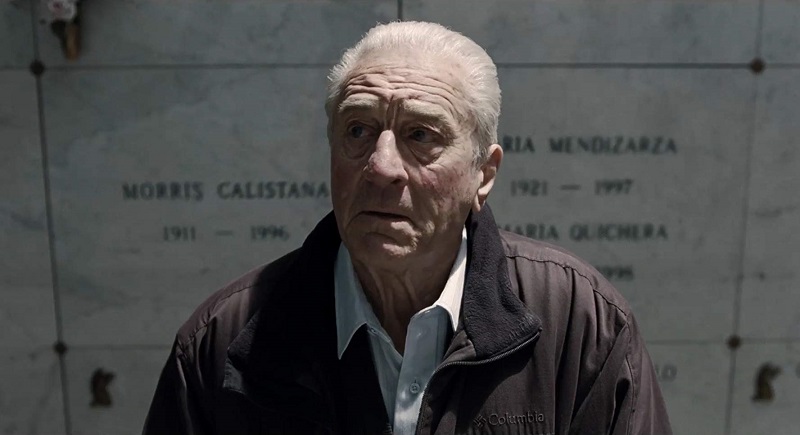
Over the film’s 210 minutes, Sheeran is given a character arc that from the outside appears to be as consistent as roles come. But—and this is hugely important—there had to be something subtly there in De Niro’s Sheeran that would find him going from Hoffa’s right-hand man to the individual who allegedly ended his life. It is all there in Zaillian’s screenplay, and is so brilliantly interwoven through the myriad of time jumps by the star and his helmer. It is perfection. Another aspect of De Niro’s performance that doesn’t get mentioned as much when saluting all his stunning characterizations over the years, and is firmly present in The Irishman, is how he keenly knows his role within an ensemble. Each actor triumphs at this facet. It could easily have been a battle of the egos, given the rich resumes each performer brings to the table. Yet it was utterly seamless and another testament to Scorsese’s camaraderie with his cast. They want to please him and bring his vision to life.
Pacino doesn’t hit the screen in the filmmaker’s latest masterwork right away. Yet, like Martin Sheen when he finally shows up in The West Wing, it is like a bomb goes off when the legendary actor first introduces us to Hoffa. It’s through a phone conversation he’s having with Sheeran, not the most ideal of scene landscapes to command an audiences’ attention. The scene is utterly delightful and let’s just say this—you will never look at painting houses the same way again!
Hoffa has a reputation and a persona that has only exponentially increased over time since his death. That can find an actor swimming upstream as they try to establish something that goes well beyond what popular consensus believes about a real life soul. Pacino attains an extraordinary feat with his performance as Hoffa. This larger-than-life historical figure comes alive with a crackling and pulsating panache. The Oscar winner never tries to ride on the coattails of the Hoffa persona and mirror it. Instead, audiences get to the heart and soul of this individual in a manner that has never been achieved onscreen. Not even with the great Jack Nicholson in Hoffa in 1992.
Pesci came out of retirement when his phone rang, and Scorsese was on the other side asking him to join his group of storytellers. His turn as Bufalino is truly the glue that cements the entire endeavor. It is Bufalino who gave Sheeran his first big break in the business. It is Bufalino who is sitting beside the titular character on the fateful road trip whose scenes are the common thread that weaves through the entire film. He also is the one who must make the tough decisions that Sheeran enforces. It is with Pesci’s performance as Bufalino—which is filled with nuances that are firmly a study in taking chances that firmly pay off—as well as how he plays his character’s friendship/mentorship with Sheeran, that that third act “reveal” carries such weight.
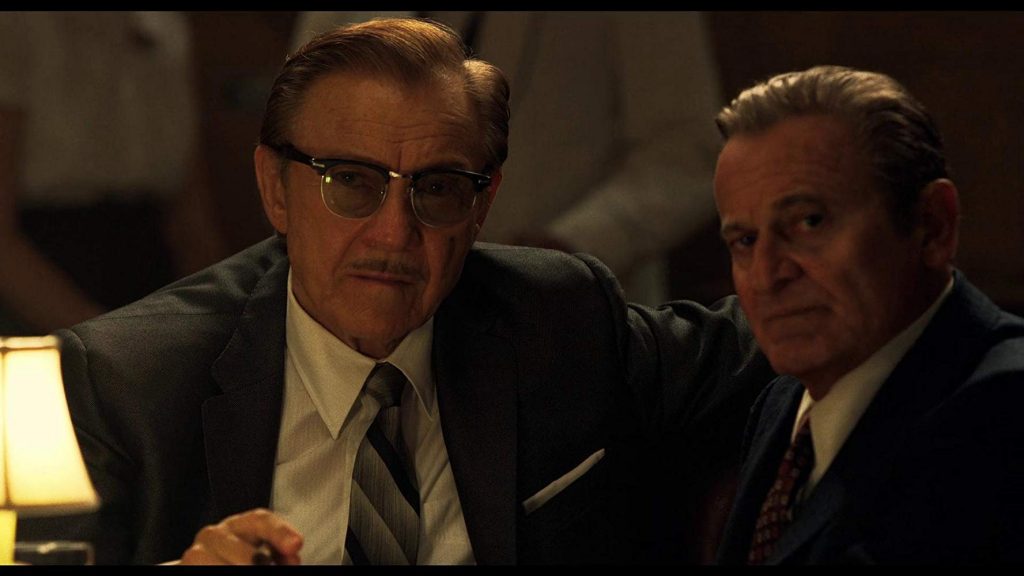
Meanwhile, Keitel does so much with so little. It is a marvel to witness the veteran bask in the glory that is the richness of his character while emitting electricity performing within this ensemble and the blissful joy that must have accompanied being directed by Scorsese. Honestly, I want a movie centered solely on Bruno to see what else there is to glean from the life of this made man.
Scorsese’s direction … what can be said that hasn’t been astutely documented already. His talent is the gift that keeps giving, year after year that he keeps working. The cinematic icon has never hinted at retirement and if what he delivers with the epic The Irishman is any indication, he shouldn’t slow down in the least. What an endeavor it must have been to tackle such a time-spanning story, ripe with landmines from historical accuracy to diving into the life and unexplained demise of an American legend. It’s one thing for Quentin Tarantino to rewrite history with the Manson family and his Once Upon a Time in Hollywood. It’s a whole different ballgame what Scorsese does with the Hoffa persona and all the satellite stories that stem from his mere existence. Some have argued that Clint Eastwood may have lost a step or two in his more mature years—as evidenced by his last several film efforts. If that is how we are basing things, then Scorsese is doing some of his best work in an advanced age that finds him with a firmer grip on sensational storytelling than ever before. His last two films—the faux documentary Rolling Thunder Revue: A Bob Dylan Story and The Irishman—could not be more diverse, but are emblematic of what we’re discussing.
The former is a look at Dylan and a tour the singer-songwriter undertook in 1975 and the latter is the definitive mob movie and look at America at a crossroads. Each brings its brilliance in the most bombastically classic Scorsese ways, while simultaneously featuring the creative passion of a genius that has us clamoring for whatever he aims his camera at next.
Speaking of music and Scorsese, no one utilizes it quite like the filmmaker. Not only do the tracks he chose serve a tonal purpose, they also add layers of emotive power. He’s never shy about using a lot of music throughout our cinematic journeys through his lens. From Goodfellas to Casino to The Wolf of Wall Street, the sonic succulence of a Scorsese film is unlike anything else experienced in the art of cinema. He is in a league all his own when it comes to song choices and what buttons they push on each one of us.
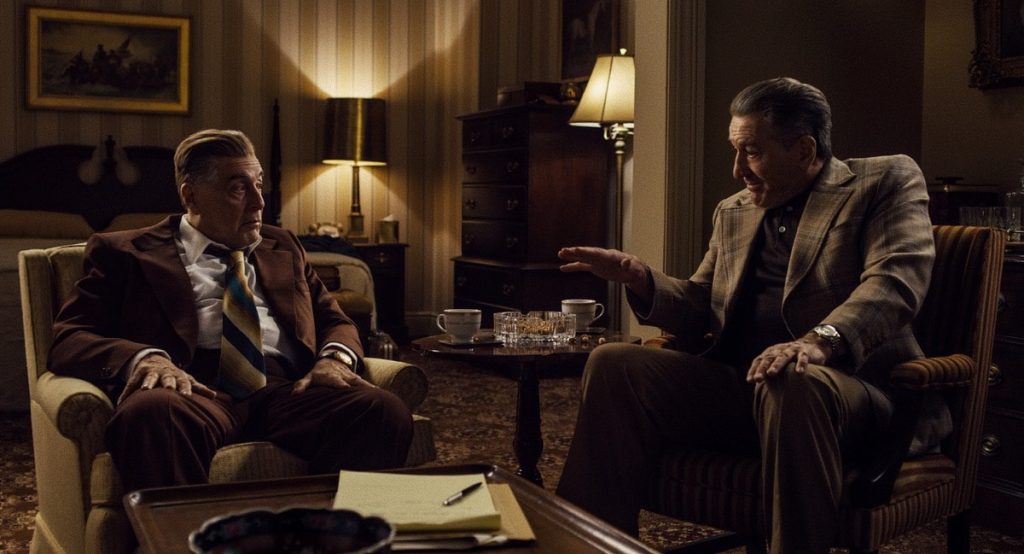
Another spoke in the awesome wheel that is The Irishman is its reflective nature. Sure, De Niro narrates from a position of looking back over a life. This sense to Scorsese’s latest film is vaster than that simplifying view of a powerful tool in his storytelling toolbox. Rarely have we experienced a film of his that so entertainingly documents its events while spurring deep and varied questions. It is easy to pose inquiries when a character is facing their final moments. This instant classic has its souls gazing backwards while still forging forward by wondering, “what does it all mean?” and “how have the choices I made influenced X, Y and Z.”
It’s a stunning emotional addition to the filmmaking firepower of a master.
Grade: A

